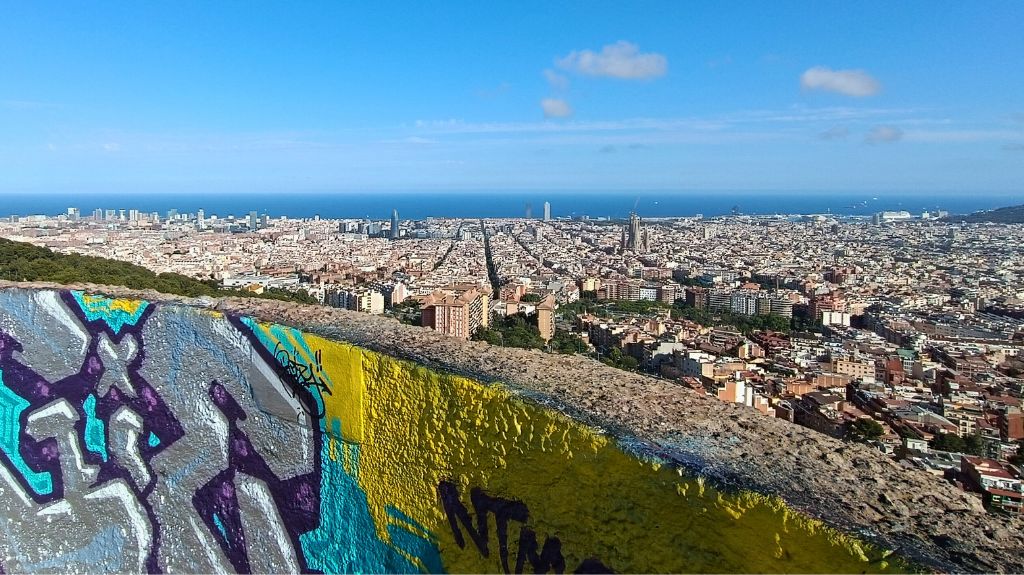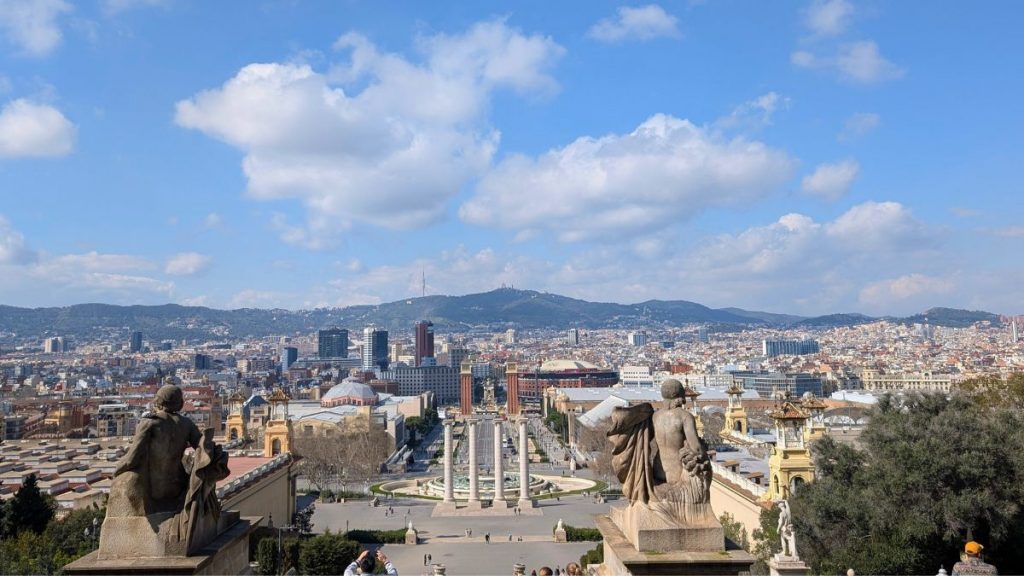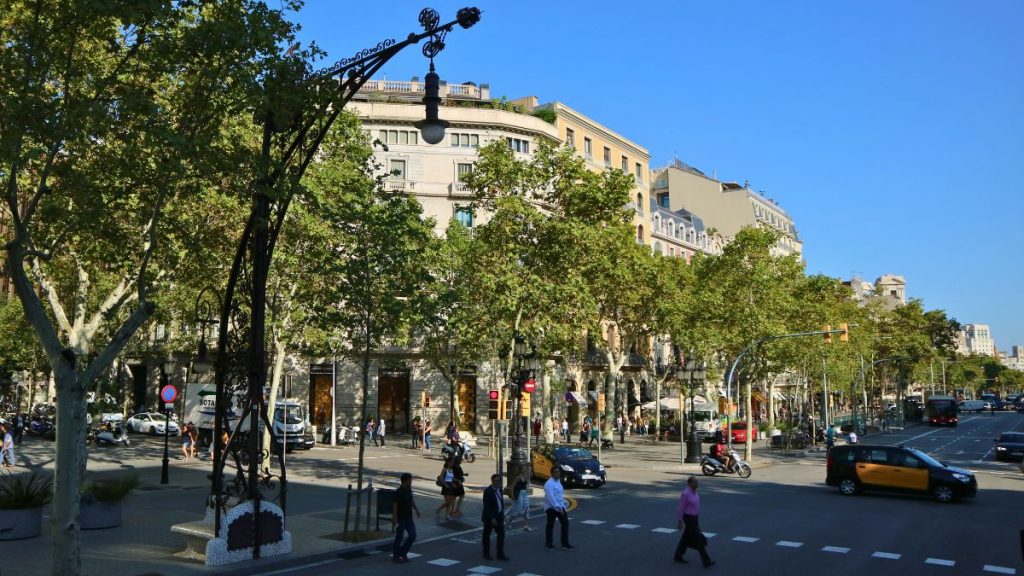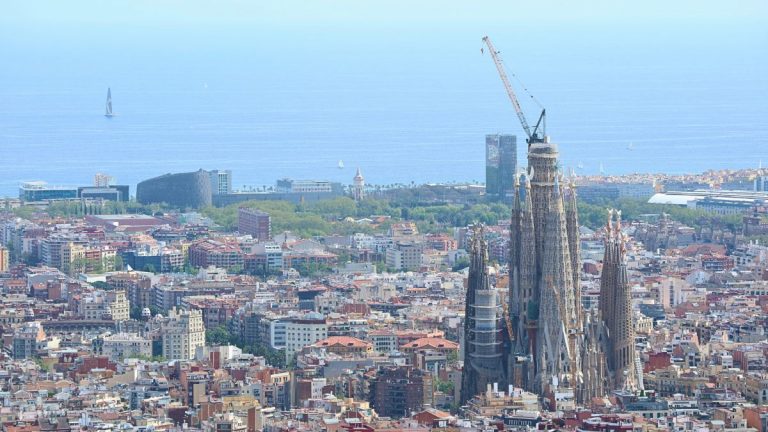Is Barcelona a Walkable City? How to Explore on Foot in 2026
Wondering if you can explore Barcelona on foot?
The short answer is yes, Barcelona is one of the most walkable cities in Europe.
I’ve spent countless days walking through its lively streets, quiet back alleys, and wide boulevards, discovering how easy it is to get around without a car or even public transport.
From historic neighborhoods to green spaces, beaches, and modernist gems, the city is full of sights you can reach on foot.
Planning a trip and want to know is Barcelona a walkable city?
Here’s your complete guide to exploring the city on foot in 2026.
Short on time? Here are my top recommendations for walking in Barcelona:
Disclaimer: This page contains affiliate links. If you purchase through one of them, I may receive a small commission from the platform at no extra cost to you. Thanks for the support!
What Makes Barcelona so Walkable

💡 Insider Tip: If you want to experience Barcelona without the hassle of planning, consider my custom travel itinerary service. Together, we can craft a personalized travel plan that caters to your interests. Let’s make your next Barcelona adventure magical!
Barcelona is one of the cities where walking feels easy and enjoyable.
Distances between major sights are short, the streets are full of life, and there’s always something interesting around the corner.
Whether you’re here for the Modernist architecture, beaches, or tapas, you’ll find most places are within reach on foot. Here’s what makes walking in Barcelona the best choice for exploring the city.
Car-Free Zones and Pedestrian Streets

Over the past decade, Barcelona has made huge efforts in reducing car traffic and giving space back to people.
One of the key projects is the superilles or “superblocks.”
These are areas where through traffic is restricted, and streets are redesigned for walking, cycling, and socializing.
You’ll spot them in neighborhoods like Gràcia, Eixample, and Poblenou. Suddenly, a former road is now a quiet plaza with benches, trees, and kids playing.
On top of that, many streets in the Old Town, especially in the Gothic Quarter, El Born, and La Ribera, are fully pedestrian.
These narrow lanes weren’t built for cars anyway, so walking is often the only way to get around.
The result: calmer, cleaner, and safer streets throughout the city.
Mostly Flat Terrain with a Compact Layout

Barcelona sits between the Mediterranean Sea and the Collserola mountain, but most of the city itself is quite flat.
Neighborhoods like Eixample, Poblenou, and the Gothic Quarter lie on level ground, which makes walking comfortable even if you’re not used to covering long distances.
The grid layout in areas like Eixample also makes it easy to navigate, while wide sidewalks and frequent crosswalks keep things moving at a good pace.
While there are hilly areas like Montjuïc and Tibidabo, these are more exceptions than the rule. Plus, you can always take public transport uphill, then enjoy a scenic downhill stroll.
Centralized Tourist Attractions

One of the biggest advantages of walking in Barcelona is how close everything is.
Most major attractions are packed into a relatively small area between Eixample and Ciutat Vella.
You can visit Sagrada Família, stroll down Passeig de Gràcia, explore the Gothic Quarter, and reach the beach, all without needing a car or even the metro.
Even places that look far on the map, like Park Güell or Montjuïc, are usually just a 30-40 minute walk from central areas.
This makes planning your days easy and lets you see more without constantly jumping between buses or trains. Plus, you’ll discover hidden cafés, courtyards, and local shops along the way. 😉
The Best Neighborhoods to Explore on Foot

Barcelona isn’t just walkable, it’s a city that rewards walking.
Each neighborhood has its own look, feel, and rhythm, and the best way to experience them is on foot. Whether you’re after historic streets, grand architecture, or a laid-back local vibe, these areas are perfect for exploring slowly.
The Gothic Quarter’s Medieval Maze
The Gothic Quarter, or Barri Gòtic, is the oldest part of Barcelona and one of the most walkable.
Its narrow alleys, small squares, and Roman ruins create a maze that’s best discovered at a slow pace. No cars can pass through most of its streets, so you’ll be walking without distractions.
You’ll pass hidden courtyards, historic churches, and buildings that date back tens of centuries.
It’s easy to get lost, but that’s half the fun.
Every turn reveals something new, whether it’s a tiny tapas bar, a tucked-away art gallery, or an old stone fountain. Start near the Cathedral of Barcelona and let your curiosity guide you.
Eixample’s Grid and Grand Boulevards

Eixample is nothing like the Gothic Quarter.
Wide sidewalks, long straight streets, and elegant architecture define this 19th-century neighborhood. It was designed to be walkable, with an impressive grid layout and chamfered corners at every intersection.
You can walk for blocks without feeling tired, especially along tree-lined boulevards like Passeig de Gràcia or La Rambla de Catalunya.
In Eixample, you’ll find Gaudí’s most famous works in Barcelona, including Sagrada Familia, Casa Batlló, and La Pedrera. Walking between them will reward you with many other architectural gems that no tourists ever see.
Shops, cafés, and bakeries fill the ground floors of the buildings, while rooftop bars and hidden courtyards offer peaceful breaks from sightseeing.
Gràcia’s Local Squares and Quiet Charm

Gràcia feels like a small town tucked inside the city.
It used to be a separate village, and you can still feel this, especially when you explore on foot.
The streets are narrow and calm, and traffic is minimal.
What makes Gràcia special are its plaças, where locals gather day and night. You can walk from one to the next, stopping for a coffee or a quick snack, and soak in the neighborhood’s daily routine.
It’s less touristy than the center, but still full of life, especially in the evenings. Gràcia is also part of Barcelona’s superblock program, so some areas are fully pedestrian.
El Born and La Ribera’s Hidden Corners

El Born and La Ribera sit next to the Gothic Quarter, but they’re quieter and more artsy.
These districts are packed with small boutiques, local designers, wine bars, and art spaces, all tucked into medieval streets.
Walking here means taking your time. There are no big boulevards, just winding passages that lead to small plazas or peaceful corners.
You can visit the impressive Santa Maria del Mar, relax in the green Parc de la Ciutadella, or explore El Born CCM.
It’s a great place for aimless wandering, and you’re never far from a cool café or a photo-worthy moment.
Poblenou’s Creative Vibe and Wide Avenues

Poblenou has transformed from an old industrial zone into one of Barcelona’s trendiest areas, and it’s best explored on foot.
The streets are broad, the sidewalks are wide, and the atmosphere feels more laid-back than the city center.
You’ll find a mix of old factories, modern architecture, street art, and creative spaces.
La Rambla del Poblenou is the heart of the neighborhood. It’s the perfect place for a long walk lined with local bakeries, cafés, and quiet bars.
It also leads you to the beach, so you can end your walk with sea views.
5 Must-Do Walking Routes in Barcelona

One of the best ways to experience Barcelona is by walking from one iconic spot to another.
Whether you want to discover modernist architecture, explore historic streets, or enjoy sea views, these walking routes give you a real sense of the city’s layout and personality.
1. From Park Güell to Sagrada Família
This scenic walk connects two of Gaudí’s masterpieces.
Start at Park Güell, where you can explore colorful mosaics, winding paths, and panoramic views of the city.
After visiting the park, follow the roads downhill through the quiet neighborhoods of El Carmel and Gràcia. The route takes you through local streets and small plazas, giving you a glimpse of daily life away from the tourist crowds.
Then, explore the octagonal grid of Eixample, before reaching the grand Sagrada Família. It rises above the city like a giant sculpture.
The walk takes about 40 minutes without stops, but give yourself more time to take photos and grab a snack along the way. It’s a great route if you want to combine famous sights with a more local feel.
2. Strolling up Passeig de Gràcia

Passeig de Gràcia is one of the most iconic streets in Barcelona. It’s also one of the most walkable.
Start near Plaça Catalunya and head uphill toward Avinguda Diagonal.
Along the way, you’ll pass some of the city’s most famous architecture, including Gaudí’s Casa Batlló and La Pedrera, as well as works by Puig i Cadafalch and Domènech i Montaner.
The sidewalks are wide and shaded by trees, with plenty of benches and designer shops. It’s a polished, elegant walk that mixes shopping, history, and design.
If you’re not in a rush, stop for a coffee or a glass of cava at one of the many terrace cafés or rooftop bars.
The route takes about 30 minutes end to end, but you’ll want to slow down and soak it all in.
3. La Rambla and the Gothic Quarter Loop

This historic route blends big sights with small surprises.
Start at the top of La Rambla near Plaça Catalunya and walk down the tree-lined boulevard toward the waterfront. Along the way, you’ll see street performers, flower stalls, and the famous La Boqueria market.
Before you reach the Columbus Monument, turn left into the Gothic Quarter and start weaving through its medieval streets.
Highlights include Plaça Reial, the Barcelona Cathedral, and tiny local shops tucked into centuries-old buildings.
You can loop back to La Rambla through Carrer del Bisbe or via Portal de l’Àngel.
The full loop takes about 45 minutes, but if you stop for food, shopping, or photos, you could easily spend a couple of hours. It’s touristy but still worth doing, especially early in the morning.
4. Walking Around Montjuïc Hill

Montjuïc is one of the few hilly areas in Barcelona, but it’s also one of the most scenic places to walk.
Start near Plaça Espanya and head uphill past the National Art Museum of Catalonia (MNAC), where you’ll get sweeping views of the city.
From there, you can follow footpaths through parks, gardens, and historical sites like Montjuïc Castle.
The area feels quiet and green, with fewer cars and more space to explore at your own pace. You’ll pass art museums, Olympic venues, and shady picnic spots.
Wear comfortable shoes as the terrain includes some stairs and gravel paths. If you don’t want to walk uphill, take the Montjuïc cable car or bus to the top, then walk down.
The full loop can take 2 to 3 hours, depending on your route, but you can shorten it easily.
5. Coastal Walk from Barceloneta to Bogatell Beach

If you want sea views, fresh air, and an easy, relaxed vibe, this is the walk to take.
Start in Barceloneta, the city’s old fishing neighborhood, and follow the seaside promenade heading northeast. You’ll pass sandy beaches, beach bars (chiringuitos), volleyball courts, and public art installations.
The path is flat and smooth, perfect for walking, biking, and people-watching. You’ll see joggers, skaters, and families enjoying the open space.
Keep going until you reach Bogatell Beach, a quieter stretch with a more local crowd.
The whole walk takes about 45 minutes one way, depending on your pace. It’s ideal in the morning or just before sunset, when the light hits the water and the city skyline glows. If you’re hungry afterward, there are plenty of seafood spots to try.
When Walking Isn’t Ideal?

Barcelona is easy to explore on foot, but there are a few times and places where walking isn’t the best option.
The city’s layout and climate can present challenges if you’re not prepared. Here are two situations when walking might be uncomfortable and how to work around them.
In the Summer Heat and Midday Sun
From June to September, Barcelona gets hot.
Afternoon temperatures often pass 30°C (86°F), and many streets are not shaded. Walking long distances in the midday sun can feel exhausting, especially if you’re not used to the heat.
Locals tend to stay indoors during these hours, stick to shaded areas, or go to the beach.
If you’re visiting in summer, try to plan most of your walking for the early morning or after 6 PM.
Carry water, wear light clothing, and don’t forget sunscreen. You can also use the metro or buses for longer stretches during the hottest part of the day, then walk once the sun eases up.
Around Steep Areas Like Montjuïc or Tibidabo
While most of Barcelona is flat, a few areas involve uphill climbs that aren’t ideal for exploring on foot.
Especially on a hot or humid day, avoid wandering around Montjuïc and Tibidabo.
Montjuïc has stairs, winding roads, and some steep trails, while Tibidabo is even higher and spread out. You’ll get great views from both, but walking up from the base can be tiring.
Luckily, there are easy alternatives. Buses, funiculars, and cable cars can get you to the top.
Once you’re there, walking around becomes much more enjoyable. Save your energy for exploring the sights and viewpoints without the long uphill slog.
Alternatives to Walking Around the City

Barcelona is great for walking, but sometimes your feet need a break or you just want to get somewhere a little faster.
Luckily, the city has a reliable and easy-to-use transport network. Whether you choose the metro, a bike, or a quick taxi ride, getting around without a car is simple.
Using Public Transportation
Barcelona’s public transport system is one of the best in Europe.
The metro is fast, clean, and covers most of the city, with trains running every few minutes. You’ll also find a wide network of buses and trams, which are useful for shorter trips or areas not served by the metro.
Tickets are affordable, and multi-day passes like the Hola Barcelona card can save you money if you use transport often.
Stations are well-marked, and announcements are made in Catalan, Spanish, and English. It’s a great option when you’re heading to spots like Park Güell, Montjuïc, or the beach, especially if it’s too hot or too far to walk.
💡 Tip: Wondering what ticket to get? Use my free Barcelona Transport Fare Calculator to find the best travel card for your trip.
Catching a Taxi or a Ride Share
If you’re in a hurry or just want door-to-door service, taxis and apps like Free Now or Cabify are easy to use in Barcelona.
Official city taxis are black and yellow, and you can hail them on the street or find them at taxi ranks near major sights and transport hubs.
Fares are metered and fairly priced, and most drivers speak enough English to get you where you need to go.
Ride-share apps often offer fixed prices and digital payment, which is super convenient.
Taxis are especially handy at night, when public transport slows down, or if you’re carrying luggage. Just avoid getting into unlicensed vehicles. Stick to the official options for safety and reliability.
Biking and Shared Mobility Options
Barcelona is a bike-friendly city with miles of dedicated bike lanes and a mostly flat layout.
You’ll see both locals and visitors cycling everywhere, from the beach to the city center.
For tourists, private bike rental shops and app-based services like Donkey Republic make it easy to pick up a bike for a few hours or a full day.
Electric scooters and mopeds are also available, but be sure to check local rules before riding.
Helmets are compulsory, and scooters must stay off sidewalks.
Cycling is especially fun along the coast, through parks, or in neighborhoods like Poblenou and Gràcia. It’s a fun, fast, and eco-friendly way to cover more ground than by walking in Barcelona.
Tips for Getting Around Barcelona on Foot

Walking is one of the best ways to experience Barcelona, but a little planning makes it even better. The right clothing, timing, and a few helpful tools can turn a good walk into a great one. Here are a few Barcelona insider tips to help you feel comfortable, stay safe, and make the most of your time on foot.
What to Wear and Carry
Barcelona’s streets are mostly smooth and flat, but they’re still best tackled in comfortable shoes.
Sneakers or sandals will keep you going all day without sore feet. In warmer months, bring sunglasses, a reusable water bottle, and a hat for extra sun protection.
If you’re walking during shoulder season or in winter, layers work best.
Avoid heavy bags or backpacks unless you really need everything in them, especially in crowded areas. A small crossbody bag with a secure zipper is more practical. You won’t need much during the day, and the lighter you pack, the more enjoyable your walk will be.
Best Times to Walk the City
Barcelona is a city that starts late and stays up late, but the best time to walk is usually in the morning.
Early hours mean cooler weather, fewer crowds, and softer light, especially in spring, summer, and early autumn.
Late afternoons and early evenings are also great, especially in the neighborhoods where locals gather for a drink or stroll after work.
Try to avoid walking long distances between 1 PM and 4 PM in the summer, when the sun is strongest. Sundays tend to be quieter, with less traffic and more locals out walking, especially in parks and pedestrian areas.
Whenever you go, take your time. Barcelona rewards slow exploration.
Safety Tips for Walking Through Crowded Zones

Barcelona is generally safe, but like many popular cities, it has its share of pickpockets. Busy areas like La Rambla, the metro, and around major landmarks attract thieves.
Keep in mind these Barcelona safety tips to stay alert and protect your belongings while walking through the city.
💡 Keep your bag zipped and in front of you. Thieves often target open or loosely worn backpacks, especially on public transport and in tourist-heavy spots.
💡 Don’t carry all your valuables at once. Leave your passport and any extra cards and cash at your accommodation.
💡 Be cautious when someone tries to distract you or gets too close to you. Classic tricks include asking for signatures, offering help, or pretending you dropped something.
💡 Use a crossbody bag or money belt for peace of mind. It’s a small change that can save you a big headache.
💡 Don’t get too distracted by Barcelona’s beauty. One of the things to know before traveling to Barcelona is that it’s an extraordinarily beautiful city. It’s easy to focus on the architecture and forget your surroundings.
FAQs About Walking in Barcelona

Is Barcelona walkable for tourists?
Barcelona is one of the most walkable cities in Europe, especially for tourists. Most major attractions are close together, and the city is full of pedestrian streets, tree-lined avenues, and public squares. Whether you’re exploring the Gothic Quarter, strolling along the beach, or heading up Passeig de Gràcia, you’ll find it’s easy to see a lot without needing a car or constant public transport.
Is Barcelona an easy city to walk around?
Yes, it’s very easy to walk around Barcelona. The city is mostly flat, especially the central areas like Eixample, Gràcia, and Ciutat Vella. Sidewalks are wide, crossings are frequent, and many streets are closed to traffic or have limited vehicle access. Navigation is simple thanks to the grid layout in parts of the city, and you’ll always find something interesting just a few blocks away.
Can you explore Barcelona on foot?
You can see a huge part of the city just by walking. Many of Barcelona’s best experiences, like discovering hidden courtyards, street art, or lively plazas, are easiest to enjoy on foot. Iconic sites such as Sagrada Família, Passeig de Gràcia, the Gothic Quarter, and the beach are all walkable. It’s the best way to experience the city’s personality and pace.
Is it safe to walk around Barcelona at night?
Yes, walking at night is generally safe, especially in well-lit and central areas. Locals and tourists are often out late, especially in neighborhoods like Gràcia, Eixample, and the Gothic Quarter. Just stay alert, avoid poorly lit backstreets, and keep your belongings secure, as pickpocketing can still happen.
Can you walk from one end of the city to the other?
Technically, yes, but it’s a long walk. From the foothills of Collserola to the beach, it could take over two hours on foot. That said, most visitors stay within a central zone that’s very walkable. For example, walking from Park Güell to the beach is doable in about an hour and a half with stops along the way. Plan your routes and combine walking with public transport if you want to go further without tiring yourself out.
So, Is Barcelona a Walkable City?
And there you have it – everything you need to know about walking in Barcelona in 2026.
From traffic-free streets and scenic walking routes to lively neighborhoods full of charm, exploring Barcelona on foot is the best way to experience the city.
Whether you’re visiting for a weekend or a week, walking lets you slow down, discover hidden corners, and soak up the local atmosphere.
So, grab a good pair of shoes, stay alert in busy areas, and hit the streets to discover why Barcelona is made for walking.

💡 Insider Tip: If you want to experience Barcelona without the hassle of planning, consider my custom travel itinerary service. Together, we can craft a personalized travel plan that caters to your interests. Let’s make your next Barcelona adventure magical!






